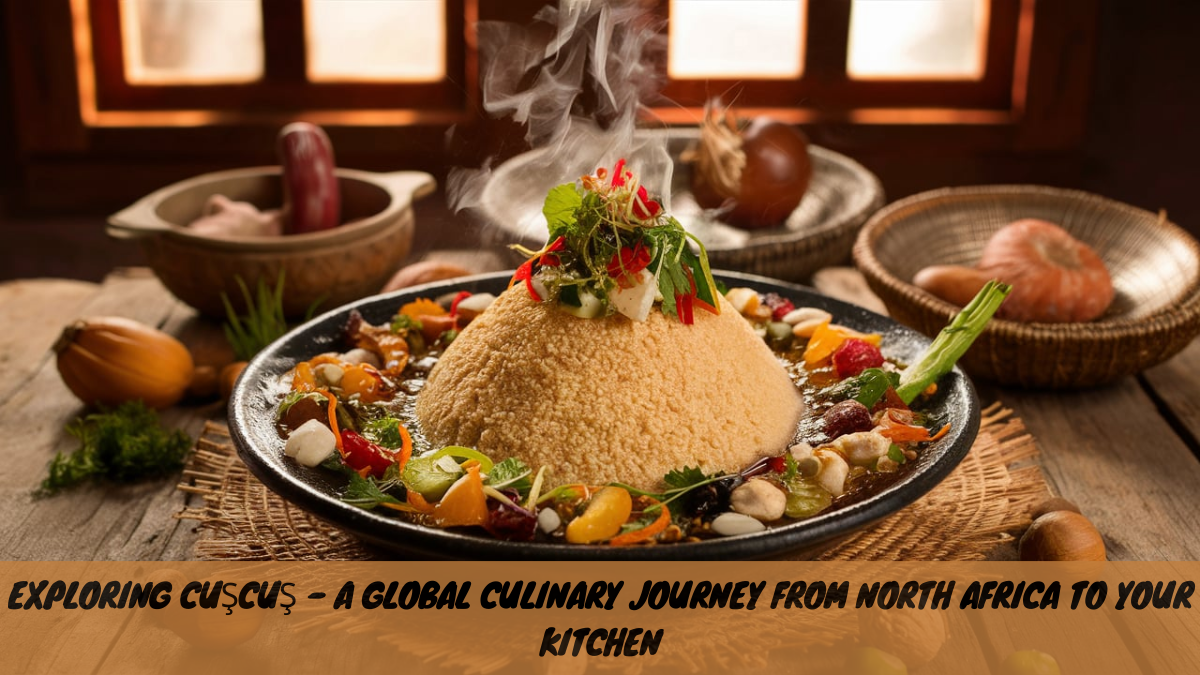Exploring Cuşcuş – A Global Culinary Journey from North Africa to Your Kitchen
Welcome to our in-depth exploration of Cuşcuş, a dish that has transcended its origins to become a beloved staple around the world.
Cuşcuş is a traditional North African dish made from steamed semolina wheat granules. It’s versatile, nutritious, and can be paired with meats, vegetables, or enjoyed in various global recipes.
Whether you’re a culinary enthusiast or just someone looking to expand your meal repertoire, this guide will introduce you to the fascinating history, nutritional benefits, and versatile recipes of Cuşcuş. By the end of this article, you’ll be equipped with everything you need to know to enjoy Cuşcuş in your own kitchen.
1. What is Cuşcuş?
Cuşcuş is a traditional dish originating from North Africa, specifically the Maghreb region, which includes countries like Morocco, Algeria, and Tunisia. It’s made from steamed semolina wheat granules, which are typically served with a stew of meat, vegetables, or both. While it shares similarities with the more commonly known couscous, Cuşcuş is a unique dish with its own distinct preparation methods and cultural significance.
Key Characteristics of Cuşcuş:
- Texture: Light, fluffy, and slightly chewy.
- Flavor: Neutral, making it a perfect base for absorbing the flavors of accompanying dishes.
- Versatility: Can be paired with a variety of ingredients, from hearty meats to fresh vegetables.
2. The Rich History of Cuşcuş
The history of Cuşcuş dates back to the 7th century, with its roots deeply embedded in the Berber culture of North Africa. The Berbers, indigenous people of the region, were the first to create and popularize this dish. Over time, Cuşcuş spread across Africa and into the Middle East and Mediterranean regions, becoming a beloved dish in many cultures.
Historical Highlights:
- Berber Origins: The Berbers, who were known for their agricultural skills, cultivated durum wheat, which is essential for making semolina. They developed the technique of rolling and steaming semolina granules to create Cuşcuş.
- Arab Influence: With the Arab invasions, Cuşcuş began to spread throughout the Islamic world, gaining popularity and evolving in its preparation and presentation.
- Mediterranean and European Integration: As trade routes expanded, Cuşcuş found its way to Mediterranean Europe, where it was embraced and adapted into local cuisines.
- Modern Global Reach: Today, Cuşcuş is enjoyed worldwide, from fine dining restaurants to home kitchens, thanks to its adaptability and nutritional benefits.
3. Nutritional Benefits of Cuşcuş
Cuşcuş is not only delicious but also packed with nutrients that can contribute to a balanced diet. Here are some of the key nutritional benefits:
Nutritional Profile:
- Carbohydrates: Cuşcuş is a rich source of complex carbohydrates, providing sustained energy throughout the day.
- Protein: While not as high in protein as some grains, Cuşcuş still offers a decent amount, especially when paired with legumes or meat.
- Fiber: Whole grain Cuşcuş is a good source of dietary fiber, aiding in digestion and promoting a healthy gut.
- Vitamins and Minerals: Cuşcuş contains essential vitamins and minerals like B vitamins, selenium, and magnesium, which support overall health.
Health Benefits:
- Weight Management: The fiber content in Cuşcuş can help you feel fuller for longer, making it easier to maintain a healthy weight.
- Heart Health: The low fat and cholesterol content, combined with selenium, contribute to a healthy heart.
- Blood Sugar Control: The complex carbohydrates in Cuşcuş can help regulate blood sugar levels, making it a good choice for those managing diabetes.
- Digestive Health: Fiber aids in digestion and prevents constipation, promoting a healthy digestive system.
4. How to Prepare Cuşcuş
Preparing Cuşcuş is a straightforward process, but it requires attention to detail to achieve the perfect texture. Here’s a step-by-step guide:
Ingredients:
- 1 cup of semolina Cuşcuş
- 1.5 cups of water or broth
- 1 tablespoon of olive oil or butter
- Salt to taste
Instructions:
- Boil the Liquid: In a medium-sized pot, bring the water or broth to a boil. Add a pinch of salt and the olive oil or butter.
- Add Cuşcuş: Remove the pot from heat and stir in the Cuşcuş, ensuring all granules are moistened.
- Cover and Steam: Cover the pot with a tight-fitting lid and let it sit for about 5-7 minutes, allowing the Cuşcuş to absorb the liquid.
- Fluff with a Fork: Once the Cuşcuş has absorbed the liquid, use a fork to fluff it gently, separating the granules to achieve a light and airy texture.
- Serve: Your Cuşcuş is now ready to be served as a side dish or incorporated into a main meal.
Tips for Perfect Cuşcuş:
- Use Broth: For added flavor, use chicken or vegetable broth instead of water.
- Seasoning: Experiment with spices like cumin, coriander, or turmeric for a flavorful twist.
- Cooking Time: Be mindful of the cooking time to prevent the Cuşcuş from becoming mushy.
5. Cuşcuş Recipes
Cuşcuş is incredibly versatile and can be used in a variety of recipes. Here are some delicious options to try:
1. Traditional Moroccan Cuşcuş
Ingredients:
- 1 cup Cuşcuş
- 1 tablespoon olive oil
- 1 teaspoon salt
- 1/2 teaspoon turmeric
- 1/2 teaspoon cumin
- 2 cups of chicken or vegetable broth
- 1/2 cup cooked chickpeas
- 1/2 cup raisins
- 1/2 cup sliced almonds
- Fresh parsley for garnish
Instructions:
- In a pot, heat the olive oil and add the Cuşcuş, stirring to coat the granules.
- Add salt, turmeric, and cumin, and continue to stir for 1-2 minutes until fragrant.
- Pour in the broth and bring to a boil.
- Remove from heat, cover, and let sit for 5 minutes.
- Fluff the Cuşcuş with a fork and mix in chickpeas, raisins, and almonds.
- Garnish with fresh parsley and serve warm.
2. Vegetable Cuşcuş Salad
Ingredients:
- 1 cup Cuşcuş
- 1.5 cups of water
- 1 tablespoon olive oil
- 1/2 cup cherry tomatoes, halved
- 1/2 cucumber, diced
- 1/4 red onion, thinly sliced
- 1/4 cup feta cheese, crumbled
- 1 tablespoon lemon juice
- Salt and pepper to taste
Instructions:
- Prepare the Cuşcuş according to the basic instructions.
- In a large bowl, combine the cooked Cuşcuş, tomatoes, cucumber, and red onion.
- Drizzle with olive oil and lemon juice, and toss to combine.
- Add feta cheese and season with salt and pepper.
- Chill for at least 30 minutes before serving.
3. Cuşcuş-Stuffed Bell Peppers
Ingredients:
- 4 large bell peppers, tops removed and seeds discarded
- 1 cup Cuşcuş
- 1 tablespoon olive oil
- 1/2 pound ground beef or turkey
- 1/2 onion, chopped
- 1/2 teaspoon garlic powder
- 1/2 teaspoon paprika
- 1/2 cup tomato sauce
- 1/4 cup shredded cheese
- Salt and pepper to taste
Instructions:
- Preheat the oven to 375°F (190°C).
- Prepare the Cuşcuş according to the basic instructions.
- In a skillet, heat the olive oil and cook the ground meat with onion, garlic powder, and paprika until browned.
- Stir in the cooked Cuşcuş and tomato sauce, and season with salt and pepper.
- Stuff the bell peppers with the Cuşcuş mixture and place them in a baking dish.
- Top with shredded cheese and bake for 25-30 minutes until the peppers are tender.
4. Cuşcuş Breakfast Bowl
Ingredients:
- 1 cup Cuşcuş
- 1.5 cups of milk or almond milk
- 1 tablespoon honey or maple syrup
- 1/2 teaspoon cinnamon
- 1/4 cup dried fruits (e.g., raisins, apricots)
- 1/4 cup nuts (e.g., almonds, walnuts)
- Fresh berries for topping
Instructions:
- In a pot, bring the milk to a gentle boil and stir in the Cuşcuş.
- Remove from heat, cover, and let sit for 5 minutes.
- Fluff the Cuş
cuş with a fork and stir in honey, cinnamon, dried fruits, and nuts.
- Serve in bowls topped with fresh berries.
6. Cuşcuş Around the World
Cuşcuş has been embraced by cultures across the globe, each adding its own unique twist to the dish. Let’s explore how Cuşcuş is enjoyed in different parts of the world:
Morocco
In Morocco, Cuşcuş is traditionally served on Fridays, a day of prayer and gathering. It’s often accompanied by a hearty stew made with lamb, chicken, or beef, and a variety of vegetables. The dish is seasoned with a blend of spices like saffron, ginger, and cinnamon, reflecting the country’s rich culinary heritage.
Tunisia
Tunisian Cuşcuş is known for its bold flavors and spicy kick. It’s commonly prepared with harissa, a spicy chili paste, and features ingredients like fish, lamb, and an array of seasonal vegetables. Tunisians also enjoy a sweet version of Cuşcuş, flavored with rose water and topped with nuts and dried fruits.
Italy
In Italy, particularly in Sicily, Cuşcuş is a popular dish with Arab influences. Sicilian Cuşcuş is often paired with fish and seafood, seasoned with saffron and a variety of herbs. It’s a testament to the island’s multicultural history and its embrace of diverse culinary traditions.
France
Cuşcuş is a beloved dish in France, especially among the North African immigrant communities. It’s commonly served in restaurants and homes, often accompanied by a spicy merguez sausage and a medley of vegetables. The French have embraced Cuşcuş as a versatile and comforting meal.
7. Cuşcuş vs. Couscous: What’s the Difference?
While the terms “Cuşcuş” and “couscous” are often used interchangeably, they can refer to different preparations depending on the region. Here’s a breakdown of the key differences:
Cuşcuş:
- Origin: North Africa, particularly the Maghreb region.
- Preparation: Traditional methods involve steaming semolina granules in a special pot called a couscoussier.
- Texture: Larger granules with a slightly chewy texture.
- Flavor: Neutral, allowing it to absorb the flavors of accompanying dishes.
Couscous:
- Origin: Middle Eastern and Mediterranean regions.
- Preparation: Often pre-steamed and dried, requiring only rehydration in hot water.
- Texture: Smaller granules with a light and fluffy texture.
- Flavor: Similar to Cuşcuş, it’s versatile and can be paired with various ingredients.
8. The Cultural Significance of Cuşcuş
Cuşcuş is more than just a dish; it’s a symbol of cultural identity and community in many parts of the world. Its preparation and consumption are often associated with important social and religious occasions.
Cultural Significance:
- Communal Meal: In North Africa, Cuşcuş is traditionally served as a communal meal, with family and friends gathered around a large platter, sharing the dish together. This communal aspect emphasizes unity and hospitality.
- Religious Occasions: Cuşcuş is often prepared for special religious occasions, such as Ramadan and Eid, highlighting its role in spiritual and cultural celebrations.
- Heritage and Identity: For many people of North African descent, Cuşcuş is a connection to their heritage and a way to preserve cultural traditions.
- Global Fusion: As Cuşcuş has spread globally, it has become a symbol of cultural fusion, blending traditional recipes with modern culinary innovations.
9. FAQs about Cuşcuş
1. What is the best way to store Cuşcuş?
Store dry Cuşcuş in an airtight container in a cool, dry place. Cooked Cuşcuş can be refrigerated for up to three days or frozen for longer storage.
2. Can Cuşcuş be made gluten-free?
Traditional Cuşcuş is made from wheat, which contains gluten. However, gluten-free versions are available, made from alternative grains like rice or corn.
3. How can I make Cuşcuş more flavorful?
Enhance the flavor of Cuşcuş by using broth instead of water, adding spices like cumin and coriander, and incorporating fresh herbs like parsley and cilantro.
4. Is Cuşcuş suitable for vegetarians and vegans?
Yes, Cuşcuş is naturally vegetarian and vegan. It can be paired with plant-based ingredients to create delicious and nutritious meals.
5. What are some popular Cuşcuş toppings?
Common toppings for Cuşcuş include roasted vegetables, grilled meats, chickpeas, dried fruits, and nuts. Experiment with different combinations to suit your taste.
10. Conclusion: Embracing Cuşcuş in Your Diet
Cuşcuş is a versatile and nutritious dish that offers endless possibilities for culinary creativity. Whether you’re savoring traditional North African recipes or experimenting with modern variations, Cuşcuş is a delicious addition to any meal. Its rich history and cultural significance make it more than just a dish—it’s a journey through flavors and traditions.
By embracing Cuşcuş in your diet, you’re not only enjoying a tasty and healthy meal but also connecting with a global culinary heritage. So why not give Cuşcuş a try and discover the joy of this remarkable dish?







